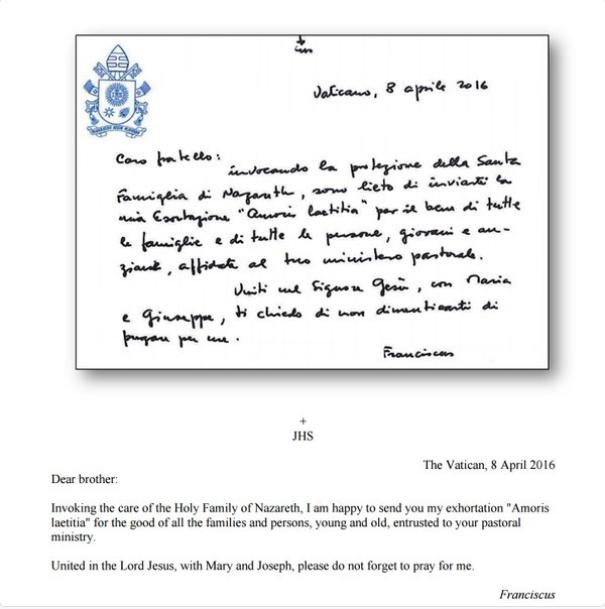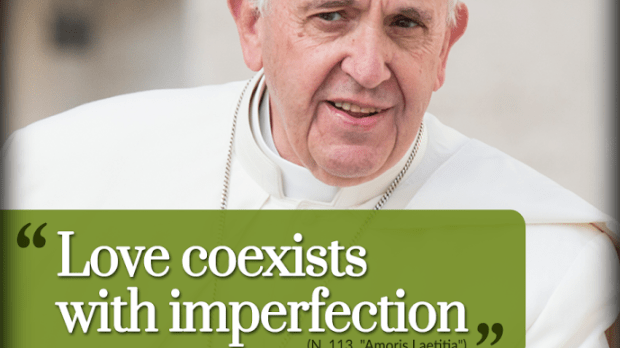
What struck me about Amoris Laetitia, is how clearly it demonstrates the consistency of Francis’ thinking, and what he seems to have embraced within his Petrine mission. There are really no surprises in this document — and no change in doctrine, because this is more about how we find the pastoral way to the doctrine — but there is clear evidence that certain themes run deep within the Holy Father’s spiritual understanding, and they are of-a-piece with a world-view that is founded not on a continual quest for “progress” but instead leads us back to what is instinctive to our humanity. Back to the garden, as it were; to what is natural.
- He talks of farmers and working the earth, just as he has before.
- He uses the word tenderness, as he has before.
- He brings up — in a particularly beautiful passage (AL28)– mothers feeding children at the breast, as he has before.
In a world that is increasingly technological, increasingly gadget-oriented, artificial and yes, increasingly distanced from its own nature as it pursues perfection — even if it means integrating with machinery — the things that the Holy Father talks about are fundamental and natural. They are not “sophisticated” things; in fact, I’m sure some might consider them as vulgar peasantries.
Which is a very good thing, actually. Bully for the peasants, say I, and for generous hearts, ready to hear and to give.
And Francis’ pastoral method is also unsophisticated; by that I do not mean it is backward, or lacking in breadth or scope, (far from it), but you might say he has a papal bedside manner that is all about the patient who needs attention in order to regain his or her spiritual health. It’s fundamental, not fundamentalist, in a “first we’ll get you back on your feet (or into the pews and the faith community) and then we’ll work on how to stay healthy (present and spiritually integrated with the church)” sort of essentialism.
In the midst of the pastoral challenges Francis lays out, he also manages to incorporate something else that is essential — the understanding that a married couple cleaving to each other in the expression of love is a true icon of the Creator. They are one, as God as one, and — tapping into John Paul II’s Theology of the Body, here — Francis notes the co-creative capacity that brings such a couple nearest to all we can understand of the mystery of God and love:
10. …It is striking that the “image of God” here refers to the couple, “male and female”. Does this mean that sex is a property of God himself, or that God has a divine female companion, as some ancient religions held? Naturally, the answer is no. We know how clearly the Bible rejects as idolatrous such beliefs…God’s transcendence is preserved, yet inasmuch as he is also the Creator, the fruitfulness of the human couple is a living and effective “image”, a visible sign of his creative act. 11. The couple that loves and begets life is a true, living icon – not an idol like those of stone or gold prohibited by the Decalogue – capable of revealing God the Creator and Saviour. For this reason, fruitful love becomes a symbol of God’s inner life (cf. Gen 1:28; 9:7; 17:2-5, 16; 28:3; 35:11; 48:3-4). This is why the Genesis account, following the “priestly tradition”, is interwoven with various genealogical accounts (cf. 4:17-22, 25-26; 5; 10; 11:10-32; 25:1-4, 12-17, 19-26; 36). The ability of human couples to beget life is the path along which the history of salvation progresses. Seen this way, the couple’s fruitful relationship becomes an image for understanding and describing the mystery of God himself, for in the Christian vision of the Trinity, God is contemplated as Father, Son and Spirit of love. The triune God is a communion of love, and the family is its living reflection. Saint John Paul II shed light on this when he said, “Our God in his deepest mystery is not solitude, but a family, for he has within himself fatherhood, sonship and the essence of the family, which is love. That love, inthe divine family, is the Holy Spirit”.6 The family is thus not unrelated to God’s very being.7 This Trinitarian dimension finds expression in the theology of Saint Paul, who relates the couple to the “mystery” of the union of Christ and the Church (cf. Eph 5:21-33).
See what I mean? That’s basic; that’s essential. To explain to human people that we are literally formed by God in a way by which he may reveal himself to us at our depths — that’s fundamental to helping us understand our worth to God. It is the first way we teach anyone the truth that, they really are acceptable to God; they have intrinsic worth.
The message that runs through Amoris Laetitia, seems to me a typically Catholic both/and; it is “look at the sign of the times” and “the prescription for what we see within them is basic and fundamental. It starts with love.” It hopes to allow people to meet Jesus, trusting that he, the Christ, will foster within them a the desire to become holy.
I said earlier that there are no surprises in this document, and there really aren’t. But there are phrases here and there that people will be sure to seize on and use out of context in order to bolster their particular perspective, or to mischaracterize the whole. One of the first responses I read from someone saying he’d only read one chapter thus far, not the whole document, but one particular footnote defined the whole exhortation for him. Well.
The thing is, this is true for pretty much everyone who is writing on Amoris Laetitia today; no one is disinterested. Every pundit is writing from his or her own perspective, and plucking phrases and themes that most speak to each of them, and that they believe will ignite the interests of their readers.
I was going to do that, too, but instead I simply urge you to do the thing that everyone really should do, before forming lasting opinions on what Francis has said here: read the whole thing, yourself.
Nothing in this document is going to “destroy the church.” It does not establish a “pathway back to the sacraments.” What we have here is a roadmap by which we can bring our spiritual life — and our understanding of who we are, and who we must be to each other — “back to the basics” — to first see the human person before us. Then to say to that person, in the mode of Francis’ predecessor, Pope Benedict XVI, “It is good that you exist.”
And then — if we are right-oriented in our spiritual lives — to say to them, “come meet this man who has told me everything about my life…” (John 4:29) and trust that as they have an encounter with Christ Jesus, through the community of faith that welcomes them, they will hunger to become holy.
100. To be open to a genuine encounter with others, “a kind look” is essential. This is incompatible with a negative attitude that readily points out other people’s shortcomings while overlooking one’s own. A kind look helps us to see beyond our own limitations, to be patient and to cooperate with others, despite our differences. Loving kindness builds bonds, cultivates relationships, creates new networks of integration and knits a firm social fabric. In this way, it grows ever stronger, for without a sense of belonging we cannot sustain a commitment to others; we end up seeking our convenience alone and life
in common becomes impossible.

